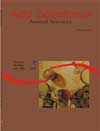Effects of high and low ruminal degradability of starch and nitrogen sources on milk production
Abstract
Four Holstein cows were tested in a Latin square with treatments in a 2x2 factorial arrangement to investigate the effects on milk production of four isonitrogenated and isoenergetic concentrates consisting of high (triticale) and low (corn) ruminal degradability starch sources and high (canola bran and urea) and low (cottonseed bran, meat and bone meal) ruminal degradability nitrogen sources. Dry matter (DM), crude protein (CP), gross energy (GE) and starch (S) intakes were affected by the interaction of starch and nitrogen sources. Dry matter and protein intakes were higher when corn and triticale combined with nitrogen source of low ruminal degradability were fed. Gross energy intake was higher when high degradability starch and nitrogen sources or low degradability starch and nitrogen sources were combined. Starch digestibility was higher for triticale-based diets. On the other hand, milk production was not affected by the treatments.Downloads
Download data is not yet available.
Published
2008-07-16
How to Cite
Zeoula, L. M., Santos, G. T. dos, Fregadolli, F. L., Watanabe, M. M., Michelan, A. C., Fridrich, D., & Morais, R. G. de. (2008). Effects of high and low ruminal degradability of starch and nitrogen sources on milk production. Acta Scientiarum. Animal Sciences, 20, 339-346. https://doi.org/10.4025/actascianimsci.v20i0.4371
Issue
Section
Zootecny
DECLARATION OF ORIGINALITY AND COPYRIGHTS
- I Declare that current article is original and has not been submitted for publication, in part or in whole, to any other national or international journal.
The copyrights belong exclusively to the authors. Published content is licensed under Creative Commons Attribution 4.0 (CC BY 4.0) guidelines, which allows sharing (copy and distribution of the material in any medium or format) and adaptation (remix, transform, and build upon the material) for any purpose, even commercially, under the terms of attribution.
Read this link for further information on how to use CC BY 4.0 properly.
0.9
2019CiteScore
29th percentile
Powered by 








































